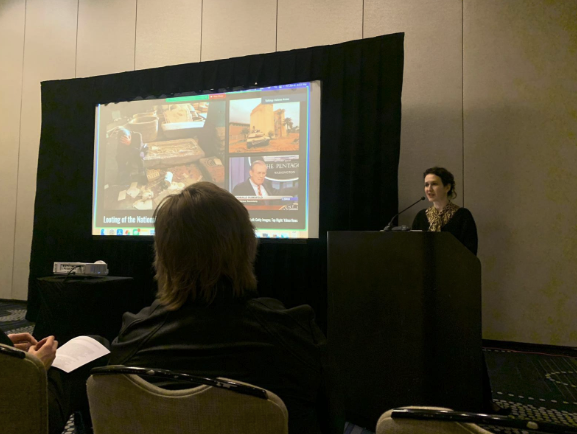The Group of Twenty (G20) makes up at least 90% of the global art market, highlighting that its member states are uniquely positioned to lead the fight against cultural racketeering. Under the 2021 Italian Presidency, the G20 prioritized combating the illicit trade, hosting events for international leaders to discuss the issue and establishing a specific working group on culture.
This focus has continued under this year’s President the Republic of India, and this year the Cultural Working Group is hosting four webinars to inform its recommendations for G20 countries to address the risks their markets face from transnational crimes via art and artifacts, including smuggling, money laundering, and terrorist financing.
On March 28, 2023, Tess Davis, Executive Director of the Antiquities Coalition, spoke during the first thematic webinar on the Protection and Restitution of Cultural Property and delivered five recommendations for the G20 to combat looting and trafficking.
- Continue to Recognize the Illicit Trade is a Serious Crime: Working towards the end goal of dismantling criminal networks through prosecutions and convictions is critical and sends the message that looting and trafficking are not white collar, victimless crimes.
- Foster a Whole of Government Approach: The Cultural Working Group could serve as a model for its Member States by taking a Whole-of-G20 approach, reinforcing the Working Groups on Trade, Investment, and Corruption as well as the Finance Track.
- Ensure Better Coordination with Member States: The Culture Working Group could encourage Member States to assign day-to-day responsibility for this issue to a senior staff person within their governments.
- Strengthen the Legal Framework: Better use of existing instruments such as the UNTOC, harmonization of national laws, and training for legislative drafters, attorneys, and judges, are all necessary steps.
- Committing to Continuing Action: An annual, high-level convening will sustain the momentum from India, Indonesia, and Italy’s Presidencies.
These recommendations are part of a larger report from the Antiquities Coalition’s G20 Task Force, Safeguarding Cultural Heritage in Conflict Zones: A Roadmap for the G20 to Combat the Illicit Trade in Cultural Objects.
During the working group’s first public program tackling the cultural racketeering crisis in 2021, Deborah Lehr, Chairman and Founder of the Antiquities Coalition, emphasized that the G20 must take collective action to end cultural racketeering.
Persistent loopholes in the global art market threaten governments and legitimate businesses by enabling corruption, money laundering, and terrorist financing. The Antiquities Coalition commends the G20 for prioritizing cultural property protection and looks forward to how it will tackle the illicit antiquities trade.








